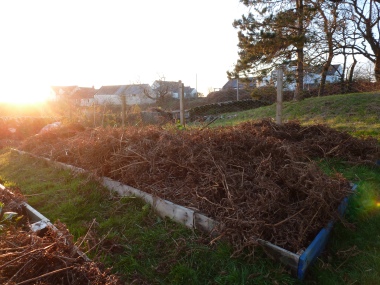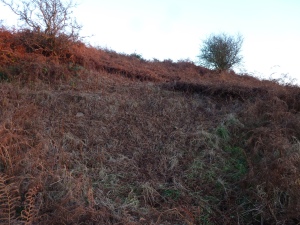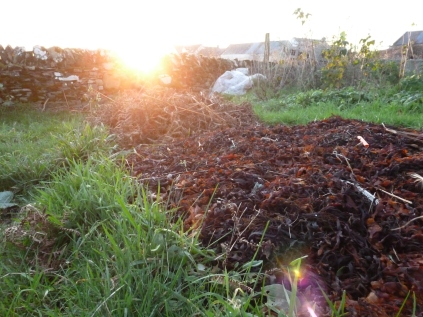We’ve not got much chutney in and Laura hasn’t made any this year, 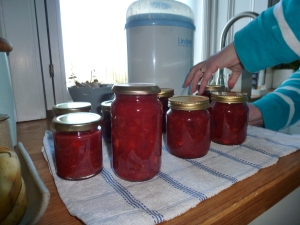 so she got to work last Sunday. This chutney has a certain whiff of Christmas, with cranberries, apples, dates, and spices used in the mix. Hardly surprising there’s a Christmas feel as all the classic Christmas ingredients are trickling in at the moment. I got the cranberries from the fish van, newly off the boat.
so she got to work last Sunday. This chutney has a certain whiff of Christmas, with cranberries, apples, dates, and spices used in the mix. Hardly surprising there’s a Christmas feel as all the classic Christmas ingredients are trickling in at the moment. I got the cranberries from the fish van, newly off the boat.
When we moved here, we had a lovely big lawn interrupted by some shrubs and a long mixed border. We’ve written about our veg. patch and the stages we’ve gone through building it. The biggest concern we’ve had is, how do we grow vegetables if we’ve got only 15cm of turf to work with before hitting stones? Our answer is to build up and do raised beds, no-dig style (the annual vs. perennial vegetable discussion is for another day). With the caveat that this may be TLDR, I’ll go into the over-thinking I went into when considering the raised beds.
We looked at top soil: expensive and not in keeping with building the veg. patch from scratch, which posed a second question: what have we got to work with? Garden compost. Bracken. Seaweed.
We used the existing garden compost from the old compost heap and have grown some fine brassicas in it this year. We’ve built two new compost bins that will start supplying garden compost next year.
I realised that bracken was a possibility when I researched methods of bracken control as part of the field improvements. In doing so, I read a few pamphlets about bracken control:
- SEARS (a Scottish Government joint venture)
- HDRA (now Garden Organic)
- One from an issue of Organic Farming, published in 2004; I can’t find it any more (the author wrote a paper on a similar subject)
The third one mentioned potential uses for bracken as a by-product of controlling it or even as a crop in itself. This was a revelation. The first use that jumped out at me was as a compost and mulch. Obvious now and a simple way to get organic matter into our veg patch.
After starting work on one area where we’re clearing the bracken for an orchard, it became apparent that bracken mulches and composts itself as a survival mechanism. Each year’s fronds die down and are flattened by the next year’s, offering a mulch to further exclude competition and as protection from the worst of the winter weather. As a result, there is a layer of excellent compost in the denser stands if you rake off the last two years’ worth of fronds. This means we have composted bracken and bracken fronds to use as soil improver and mulch respectively.
The photos of the bracken mulch show how much we are piling on in one session. It reduces an awful lot.
Our bracken management plan has now got two aspects.
- One is using the bracken from areas that we’ve not go plans for yet (exposed slopes and the like). This harvesting allows frost to get in and boosts the under layer, weakening and containing the bracken. It should hopefully stop the spread in some areas. The bracken’s utility as a crop for the garden means we’d like to keep some of it in less useful areas. The photo shows one area that we harvested.
- Removing the bracken from areas we want to use for something else. Here we strim three times a year (spring and summer). The other approach is using the pigs to dig up and destroy the rhizomes. This will severely weaken the bracken, though we may need to strim a bi to finish the job. Pigs aren’t eating the bracken (it’s unpalatable to livestock in the main).
In the second aspect, we have to have a replacement for the bracken, otherwise the soil will erode. So far we’ve planted an orchard with under-planting of raspberries, strawberries and wildflowers. Some grass is regenerating too. When the pigs are finished we’ll use more trees there to hold it together. You can see the current situation in the photo below. The slope was dense bracken like the patch on the right.
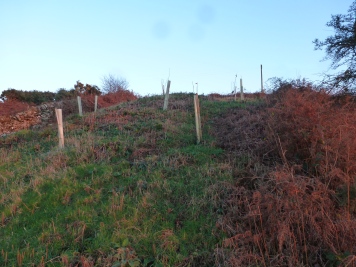 The final component is seaweed. Not long after we moved here, a lady suggested that we should take bags with us to the beach every time we went and then set the children to collecting seaweed for the garden. It’s a great idea and one we’ve done on and off as free hands have allowed. Below is some seaweed mulch.
The final component is seaweed. Not long after we moved here, a lady suggested that we should take bags with us to the beach every time we went and then set the children to collecting seaweed for the garden. It’s a great idea and one we’ve done on and off as free hands have allowed. Below is some seaweed mulch.
 A free, sunny Sunday meant a trip out, so we went to Cairn Holy, a place that’s been on our list for a while. The site is split into two Neolithic burial cairns, each of which is in an area of neat grass enclosed by dykes and a bit of fence. Before we went we looked it up in The Modern Antiquarian a book which everyone should own. Whenever we have a WWOOFer who expresses an interest in historic sites, we whip it out to astound them with the local prehistory.
A free, sunny Sunday meant a trip out, so we went to Cairn Holy, a place that’s been on our list for a while. The site is split into two Neolithic burial cairns, each of which is in an area of neat grass enclosed by dykes and a bit of fence. Before we went we looked it up in The Modern Antiquarian a book which everyone should own. Whenever we have a WWOOFer who expresses an interest in historic sites, we whip it out to astound them with the local prehistory.
 Our latest WWOOFer, Mikayla, had arrived the day before so we invited her along for the day. She is from the USA and is keen to see castles and other historic sites, so we took her back to almost the beginning. The weather was lovely up at the cairns and we were too hot at points. The view out to sea was tremendous, almost blinding in the sunlight. It was a good introduction to Galloway for our guest.
Our latest WWOOFer, Mikayla, had arrived the day before so we invited her along for the day. She is from the USA and is keen to see castles and other historic sites, so we took her back to almost the beginning. The weather was lovely up at the cairns and we were too hot at points. The view out to sea was tremendous, almost blinding in the sunlight. It was a good introduction to Galloway for our guest.
After all the excitement, we went to Mossyard for a picnic, as it is close to Cairn Holy. The tide was fully in when we arrived, which left a tiny bit of sand and a lot of rocks. When we left at 3ish we could walk to the first island along a sand bank; the one with the labyrinth was still out of reach.


